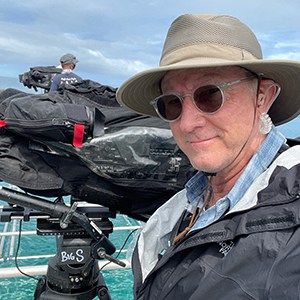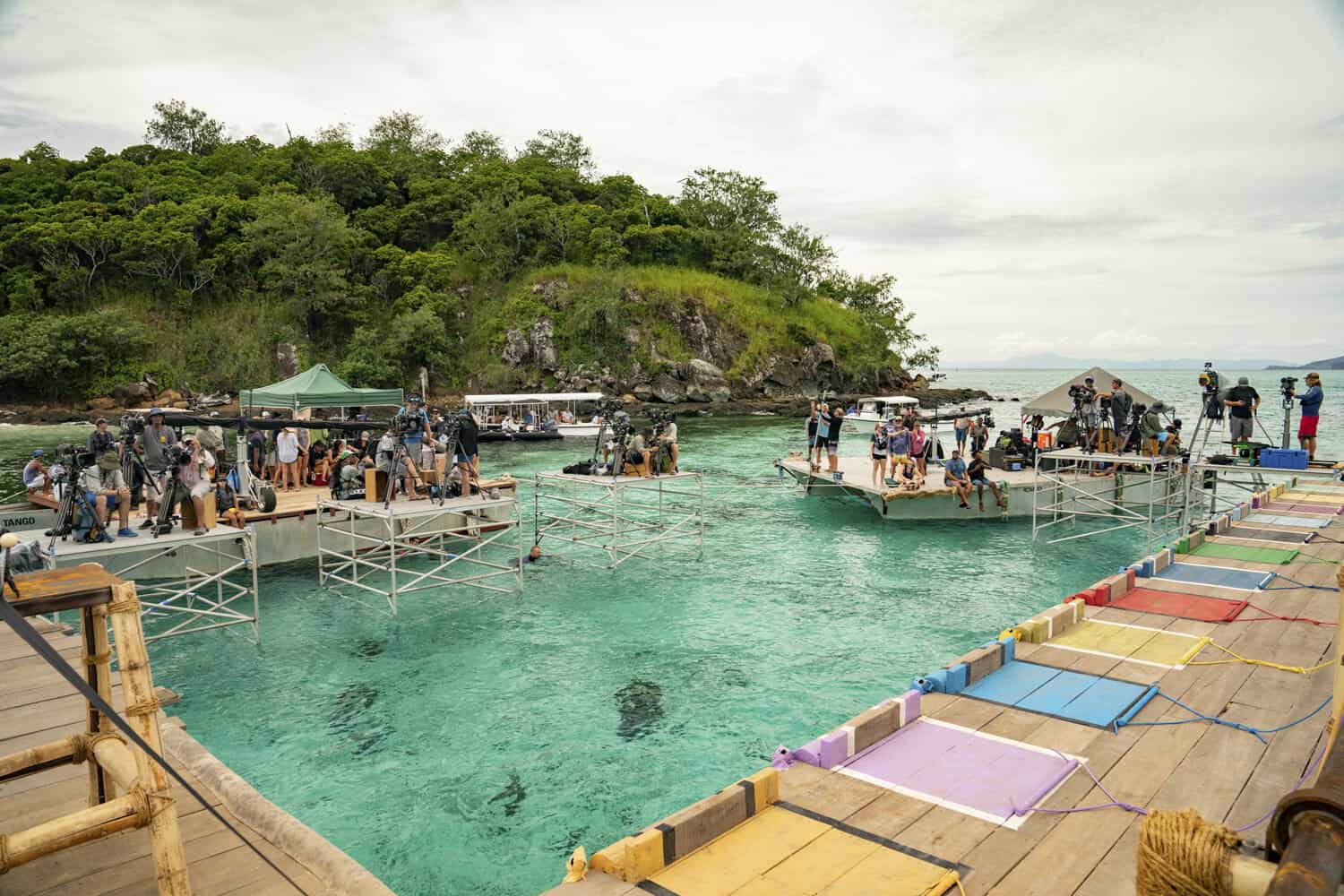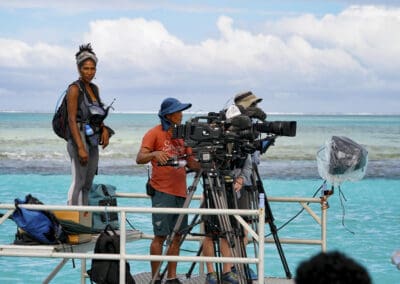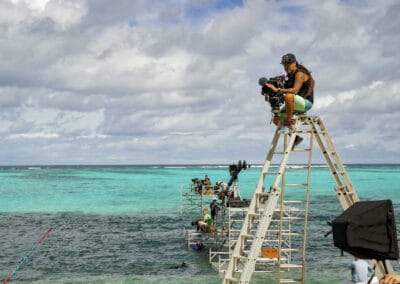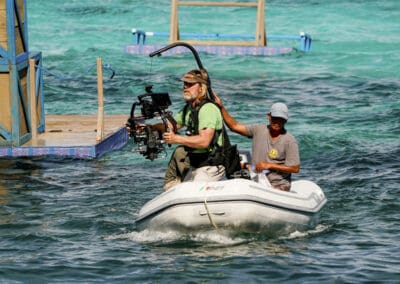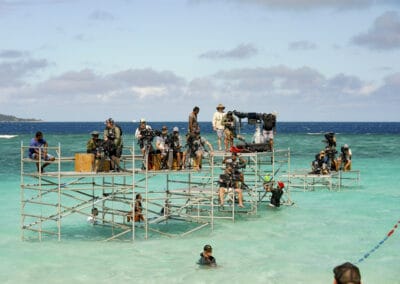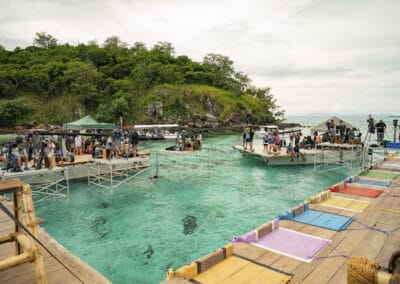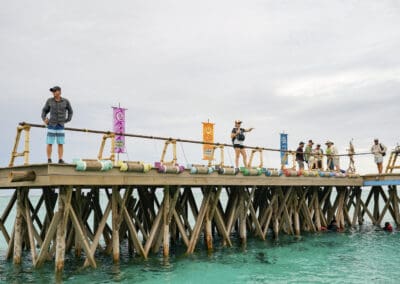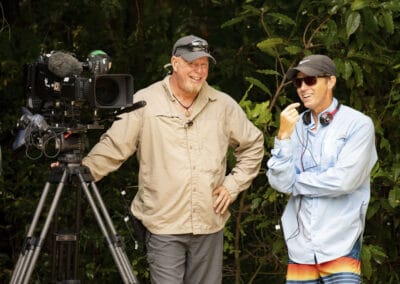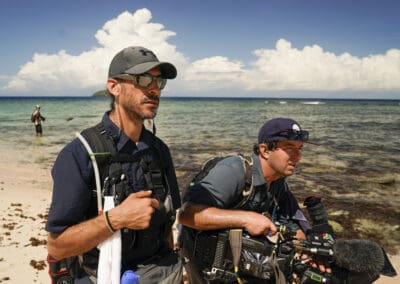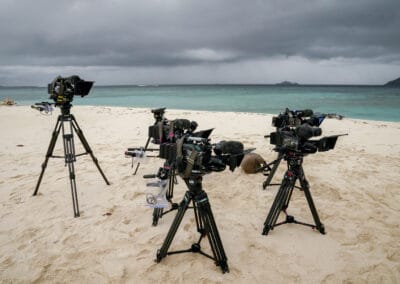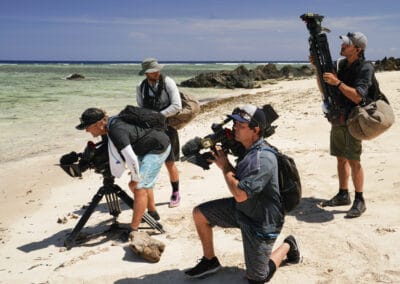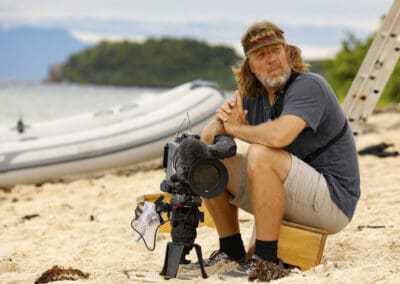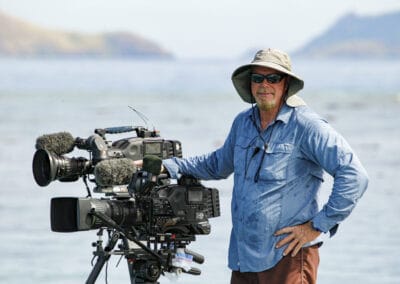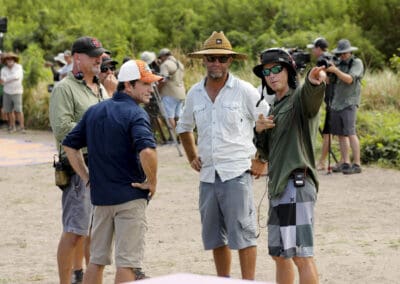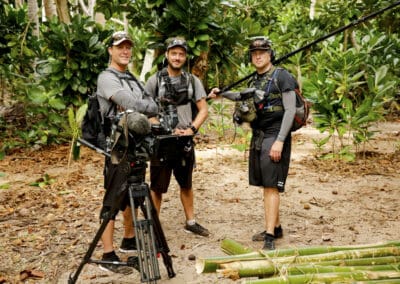SURVIVOR Seasons 41 and 42: Beyond Surviving
Part II
By David Frederick, SOC
Survivor is the American version of the international Survivor reality competition television franchise, derived from the Swedish television series Expedition Robinson created by Charlie Parsons, which premiered in 1997. The Emmy Award–winning American series premiered on May 31, 2000, on CBS. It is hosted by television personality Jeff Probst, also an executive producer along with Mark Burnett and the original creator, Parsons.
The show places a group of strangers in an isolated location, where they must provide food, fire, and shelter for themselves. The contestants compete in Challenges, including testing the contestants’ physical abilities like running and swimming, or their mental abilities like puzzles and endurance challenges, for rewards and immunity from elimination. The contestants are progressively eliminated from the game as they are voted out by their fellow contestants until only one remains and is given the title of “Sole Survivor” and is awarded the grand prize of US$1,000,000. (Source: Wikipedia)

SURVIVOR 40: WINNERS AT WAR, Day 1.
THE INTERNATIONAL COMPOSITION OF SURVIVOR
The lead Challenge AC and junior camera operator Erick Sarmiento, from Panama, started on Survivor the second year the show was in Panama, Season 8. It was the Survivor All Stars season. “I started in the Dream Team, which was like a PA position. After that, I lost contact with the show a few years until I met a Reality camera operator in Canada who brought my name back as a Reality AC. The next year I went to Challenge and stayed there since.”
Erick pointed out, “I am the lead AC for Challenge camera crew. There are eight ACs in the Challenge crew. We are using the SONY F-800 XDCam for more than the last ten years for all of our Challenges and Reality filming. There are there are 16 cameras total on Challenge side, and 15 cameras on the Reality side.” (That’s over 30 camera bodies here in Fiji, of just the SONY XDCam HD cameras. This year we are trying out the 4K version as well in tests.) “We have two Jibs, two Host cameras with 28-by and 25-by zoom lenses. Sometimes I shoot second Host camera. I also shoot one of the four underwater cameras. We are also use two 40-by long zooms, and the rest of them use the 23-by, and John Tattersall uses the wide lens on the hand-held Challenge coverage. In addition, on Challenge, we have a cable cam and about ten GoPro POV cameras.”
Survivor director of photography Scott Duncan has another collection of ARRI cameras and lenses that he owns and uses to shoot the special promotional pieces. Second unit DP Russ Fill has RED cameras and underwater housings that he uses for his special 2nd units. Camera equipment is rented from VER. There are about 40 full-sized camera bodies being used on Survivor, plus another ten GoPros, the cable cam with the SONY FX3, and the four DJI Drone cameras.
Erick continued, “In our underwater work, when there are three tribes in a water challenge, we have three underwater camera operators with GoPros in a dome housing. The footage is very clear and exciting, and the audience can see the contestants getting something or some game action underwater to advance the challenge. When there are three tribes, I will operate an underwater camera with Mofi Laguna and Paulo Veloso.”
It was a great treat to meet Louis Powell, an avid fisherman and an entertaining storyteller, but his day job is as a top-notch Reality camera operator on Survivor.
I asked Louis about his start on Survivor. “I started in Micronesia on Season 16 as an AC and did five or six seasons before getting the junior shooter position. A junior shooter is the AC for the DP of the show, and you get 10 or more shooting days in a season, then I got a full shooter spot. I’ve done 25 seasons so far.“
Louis had this to add about how he got started doing his work: “I started making surf movies with my friends who were really good surfers, but quickly realized I needed to learn a lot more about filmmaking, so I went to film school. I was in my third year in Cape Town, South Africa, and this guy (Lee Doig) came to talk about reality TV. I walked in and he looked very familiar. Turns out he was from the same small coastal town, south of Durban, that I was from. We clicked. Three years later his AC on Survivor got the junior shooting spot, and he offered me the job. The rest is history.”
Louis shared with me about being a reality camera operator that “Reality camera on Survivor is a combination of storytelling, self-directing single camera, and dancing multi-cam. Sometimes you are shooting a five-person conversation by yourself and sometimes you’re cross-shooting three different conversations with four or five other crews. Lines change all the time and you have to be fluid but solid, matching or complimenting the shots your friends are getting while following the story. All the while, our audio brothers and sisters are dancing around in the H position getting what we need to keep it all together.”
“It’s great when you can look at another shooter and instantly know that they ‘get it.’ Then you don’t have to worry about what their angle looks like or who they are covering. Most of us have been shooting together for a long time and we sometimes communicate without words—it’s mostly eye movements and head nods, or snarls and smiles. Then when the day is done we drink beer and laugh. These guys are my brothers.”
When I spoke with the camera operators about the notion of the Survivor family, Louis is a telling example of the closeness that can develop. “I met a girl working on Survivor who was also based in Los Angeles and who probably wasn’t going to move to Cape Town for this dodgy Saffa! She’s now my wife and we’ve been married for ten years and are based in LA.”
Additionally, Louis spoke about the missing crew this year. “Our Survivor family is really what brings me back every year. Most of my closest friends are on the crew. It’s such an international crew, and a large contingency of South Africans, which makes it feel a bit like a home away from home. Unfortunately, the South African crew wasn’t allowed in Fiji this year because of the country’s concerns over a new variant of COVID in South Africa. Their presence was definitely missed.”
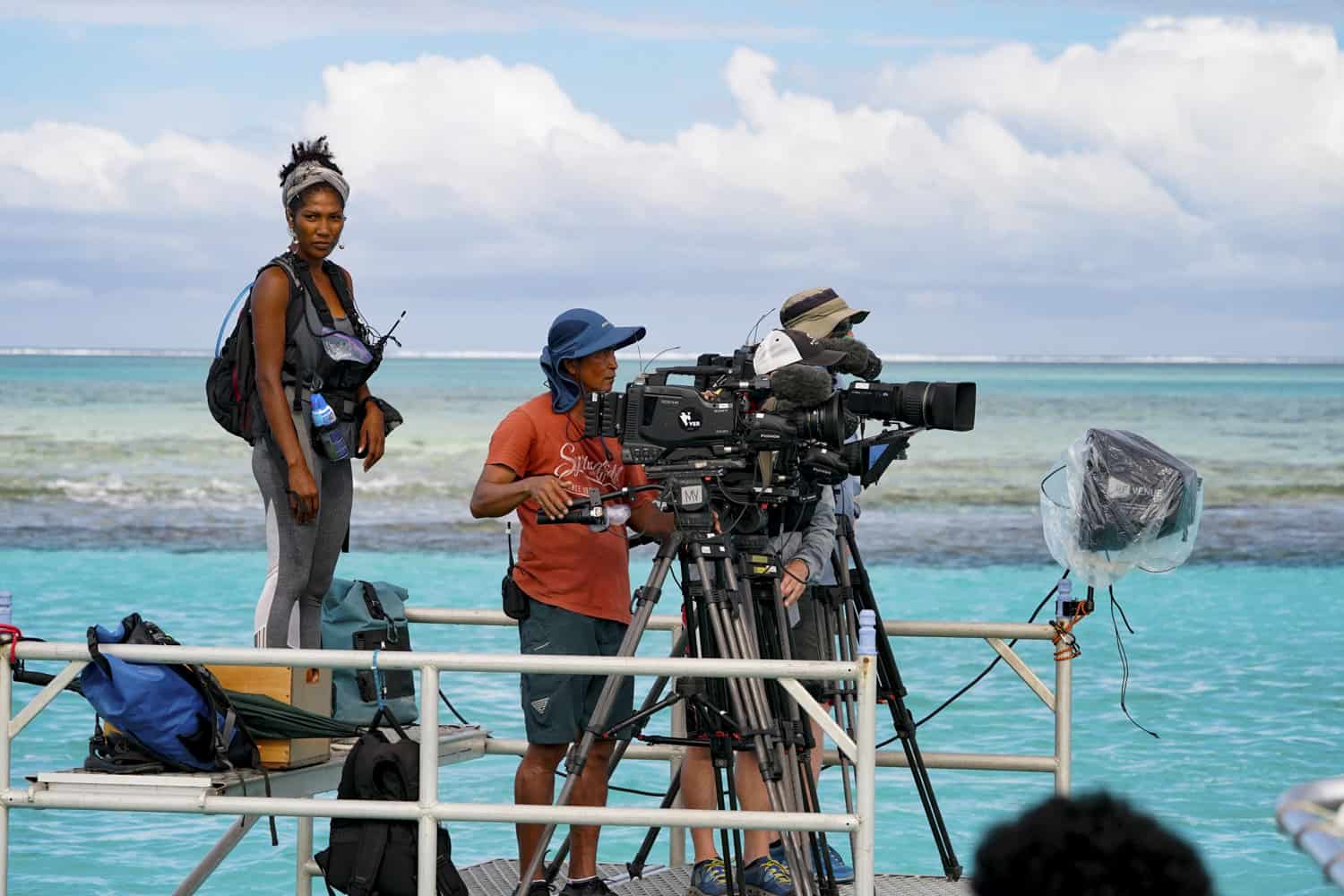
SURVIVOR 40: WINNERS AT WAR, Day 11.
Russ Fill, the second unit director of photography, is a passionate photography enthusiast. He has found himself defining his window of the world in a camera frame. There is barely a moment in the day that Russ is not bringing his new tech or antique classic camera to a site where he can capture an image and then take it back to his hotel room and develop it to make artful prints of his work. He has the same passion with his motion picture camera work.
I spoke with Russ about his history on Survivor. Russ told me, “I was asked to work on the show after working on another one of Mark Burnett’s productions called Combat Mission back in 2002. That show introduced me to the Survivor crew and set me up to start working on Survivor, Season 4, Marquesas.”
“We were actually supposed to do the show in the Middle East in Jordan. And then 9/11 happened and that drastically changed everything, not only for us on Survivor, but the world. Survivor location scouts had other locations that they had been looking at before Jordan and we ended up going to the furthest Northern Island in the Tahitian chain called Nuku Hiva, known for some of the last cannibalism on the planet. I’ve done 39 out of 42 seasons.”
I soon discovered that Russ has the inside track on nearly every aspect of the show and also has the means to articulate his impression of what is either aligned with that, or not. Ask Russ any question about the show’s process and you will get a very thoughtful response. Thinking about the evolution of his work, Russ recollects, “From working on Survivor my first season, my role has changed drastically. I was brought on as a camera operator for the Challenge crew, which also works on Tribal Council. Sometime during the first Samoa season, my role started to change. I brought a RED One camera to set and just started playing around with B-roll and other possibilities.”
“My title on the show is 2nd unit director of photography. It barely scratches the surface of what I do. All of the footage that you see when you hear host Jeff Probst describing the game, I film. If it’s in slow motion, that’s more of the work that I do. I also do a lot of specialty underwater work. The iconic banners, idols and things that have been separately shot in a beautiful location or underwater, in a really unique sort of way, featuring an item and location, is more of the work that I do.”
“On any given season, or episode within that season, I use a multitude of different pieces of equipment. My go-to camera for my second unit shots is my personal full-frame RED MONSTRO. I have used RED cameras since the RED One days back on the first Samoa season. The RED camera platform allows me to quickly change formats and frame rates, and to be able to jump from slow-mo to time-lapse and back to slo-mo. It really is a workhorse for me in a short production time situation.”
“A quick list of my filming contributions to Survivor would include second unit images of the Challenges: game explanation, puzzle animations, idol transitions, drone shots of the Challenge and setup, and the cool images to dazzle and excite our viewers about the game. I direct the 2nd unit drone work for the Challenges, film slow motion of the cast, do specialty shots for promos, and underwater images of wildlife. I film lots of idols, banners, carved totems, and shoot time-lapse with motion control. The Tribal Council 2nd unit includes the torch snuff and specialty shots featuring torches, or notes revealed by cast. It might be as simple as just some awesome slo-motion of fire that will be used for transitions or promotion.”
“I have to mention that we have some other very talented time lapse mo-co camera operators working a lot more than me on those iconic time-lapse. Paulo Castillo for one, and a few others.”
On the opposite spectrum to Russ Fill, who is a wizened, world traveler and a Survivor veteran pro DP/camera operator, is the young, yet equally capable, first-year-on-Survivor Reality AC, Hayden Gilmour.
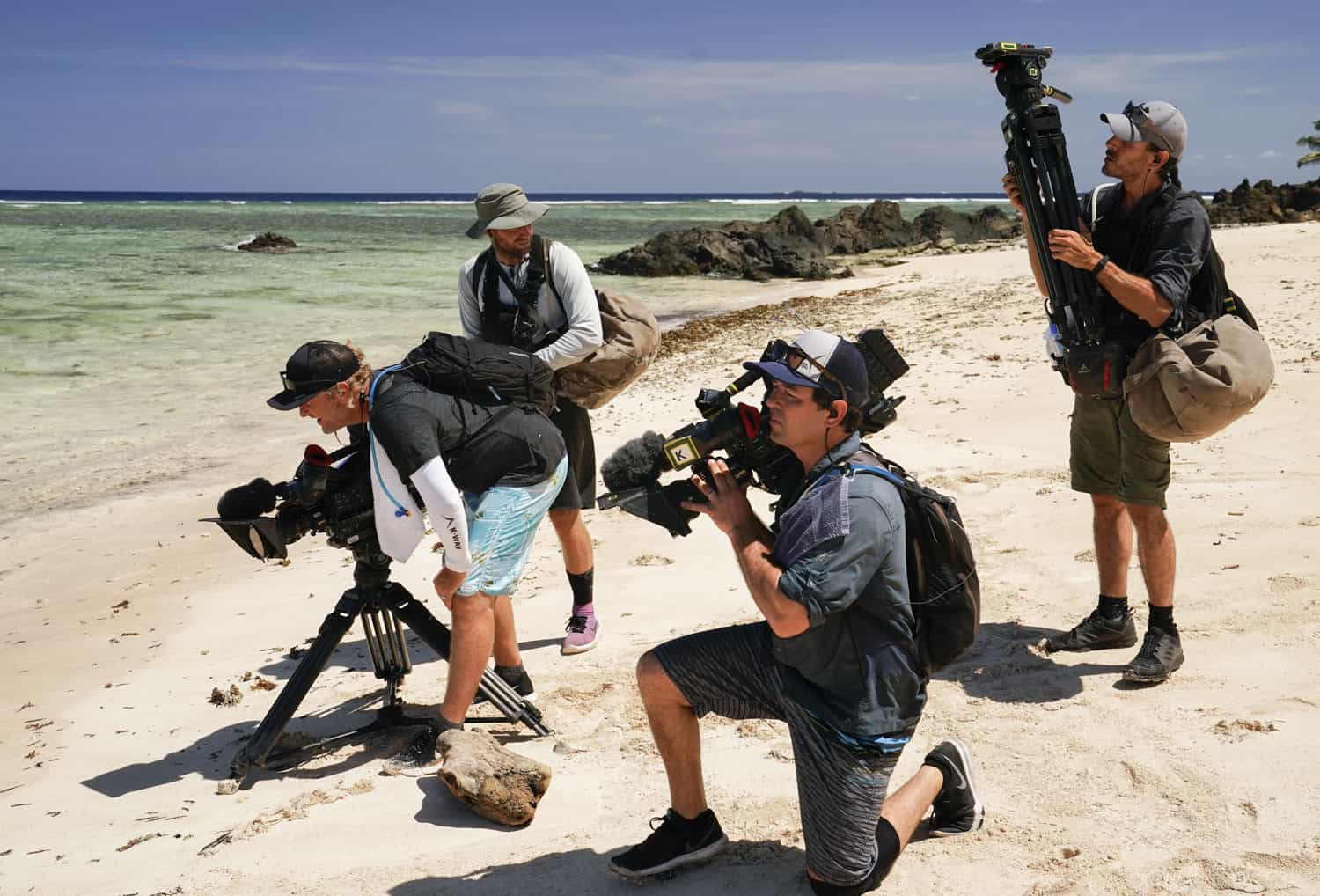
SURVIVOR 39: ISLAND OF THE IDOLS, Day 15.
DIVERSITY IN THE CREW
Out of a sense of dedication to telling a widely diverse story about the camera crew, I spoke with Hayden about her first impressions of working on the Survivor crew. Hayden enthusiastically replied, “After finishing up my very first season of Survivor, I was completely blown away by the experience. It was hard to find ways to describe it to family and friends when I finally got back home to Ketchum, Idaho (Sun Valley). My overall impression of the job itself was that it was truly the hardest I have ever pushed my body and my mind as an AC, but in the best way possible. The people I was fortunate enough to work with taught me more than I could have ever asked for, and the places and things I was able to see and experience on the job were unbelievable.”
Hayden continued, “My role on the Survivor camera crew was as AC on a Reality camera team. I was paired up with the two coolest guys, camera operators Josh Bartel and audio operator Luke McLean—and we worked both seasons as a trio. In our little crew, I was responsible for all things camera (in essence, that Sony F800 was my baby and I was not to let anything happen to it). I would also carry any necessary equipment while Josh was filming, follow closely behind him as we tracked contestants with new disks and batteries, jump into the water with the GoPro whenever the opportunity to film underwater would arise, and lots and lots of backtracking down mangled tree-ridden trails. As a reality AC, it was also very important that we were following the story within the contestants very closely by listening intently with our IFBs so we could relay any important moments that may have taken place out of earshot from the producers.”
When asked how she was able to get hired on the show, Hayden replied, “I owe my start on Survivor to my camera operator, Josh Bartel, who brought me along as his AC this year. He had worked on the show before and thought highly enough of me to trust me as his AC through Seasons 41 and 42. I am very thankful to him for helping me along through this entire experience, and to Luke McLean, as well, who taught me a great deal and always put a smile on everyone’s face out there.”
Hayden has a smile and a spirit that can light up a very large room. Her positivity was certainly appreciated as a powerful ingredient to the Survivor crew vibe. She adds, “The most memorable things for me on Survivor were the tiny little wondrous moments in between the madness. For example, the boat rides at 5 a.m., watching the sun come up, the rainstorms on the islands that added even more adventure to our day, filming on a white sandy beach at midnight while the moon lit up the whole island, and laughing with my fellow crew members as we shared stories and got to know each other so well.”
We all shared the bond of the Survivor esprit d’corps, and Hayden sums it up well. “There is something very special about working on Survivor. It’s not something that you’d ever want to miss out on doing again should you get the chance to. I think a lot of that has to do with not only the overall fact that Survivor truly is the real deal when it comes to television production, but the ‘Survivor Family” that develops a result of the incredible bond we as a crew come to share. We lean on each other when we need to and definitely know how to have fun. When I’m not working on Survivor, I do freelance work as a videographer/editor and also work with the fire department as an EMT and ski patroller in the winter.”
Camera operator Josh Bartel, who Hayden acknowledges for including her in his Reality camera crew trio, spoke with me about his own start on Survivor. “I was born in the United States but grew up in Colombia, South America, from age three, returning to the America at age 18. Presently, I am based out of San Diego, California. Season 42 will be my eighth season on Survivor. I did six seasons as a Dream Teamer, AC, tech assistant, and segment producer. I took a long hiatus, then came back as a camera operator 15 years later.”
I was curious about his taking a hiatus from the job, thinking that it was an employment risk. Josh explained, “I left Survivor because I hit my ceiling, at that time they didn’t promote from within and I was an AC on other shows. I only tech assisted because I had outlived my AC interest on Survivor. I followed with segment producing because there were no camera job openings. I became a camera operator and AC on other jobs. I worked on The Bachelor and other Mark Burnett shows as an AC with opportunities to move up faster to shoot and eventually started shooting full time.”
Josh continued, “I worked as a Survivor segment producer on the season in Gabon, in equatorial Africa, because the overnight segment producers were responsible for shooting at night. We would spend the night with an infrared camera babysitting the cast, and do our own little interviews and OTFs as well. Essentially, I was a camera operator that was producing more than a producer that was shooting. That was fun.”
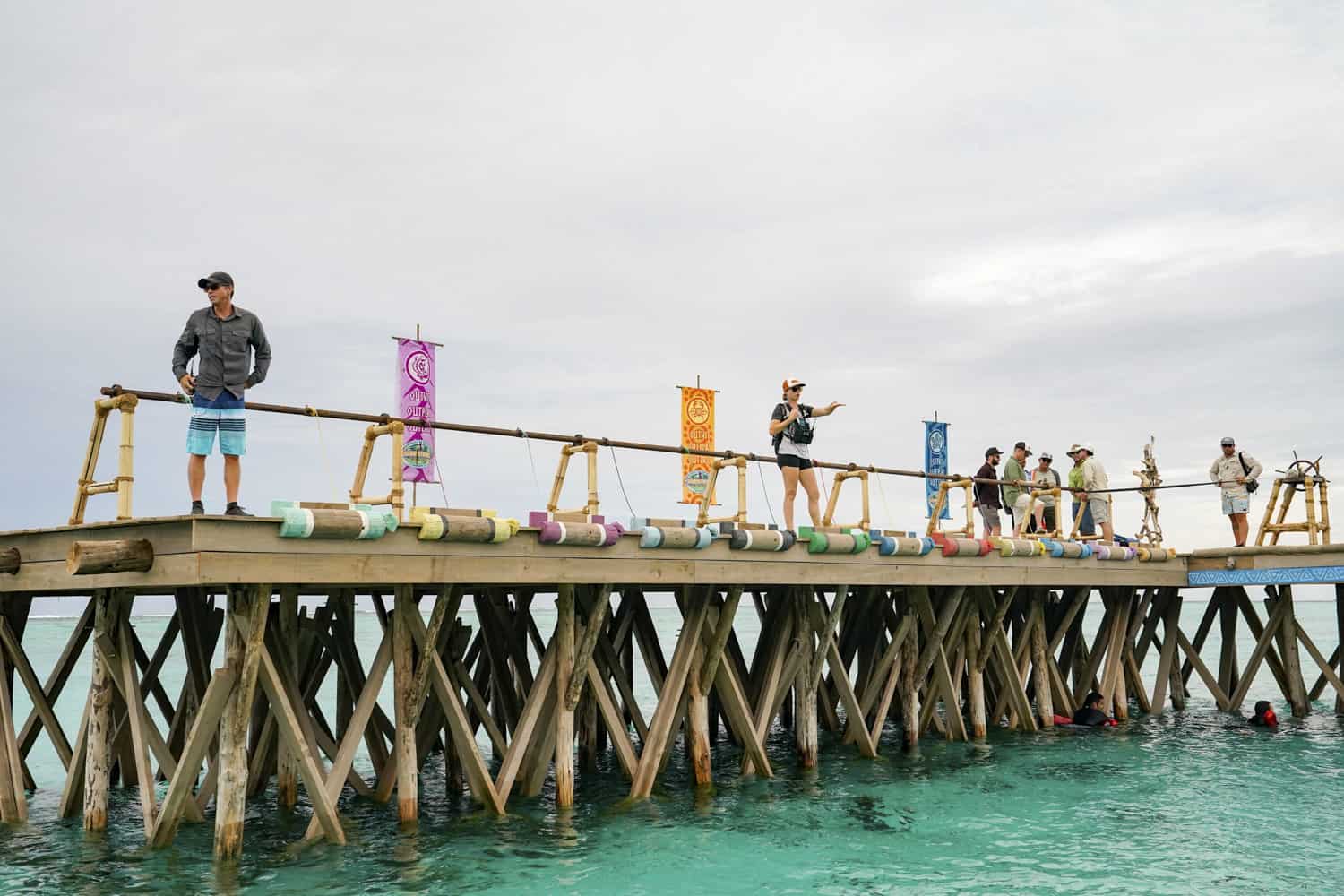
SURVIVOR 39: ISLAND OF THE IDOLS, Day 24.
Survivor leadership is very aware of diversity in the workplace. Josh explains his experience with the hard work of the show and how it affects diversity. “When I was working at my first round of Survivor, we would change countries every single season. So you’d go in the summertime, work for 50 days, leave for three months and come back in November. In that time, the unit workers would pack up everything in containers, go to a different place, break everything out, build a brand new Tribal Council. They were hard times even with the accommodations, the transportation, and the food. There was one season where we spent the first two weeks sleeping in tents in Africa because they hadn’t finished building our little village for us. It was awful. It was 100 degrees, and I was the night shift. And so you’re trying to sleep in a tent, during the heat of day, just sweating like crazy.”
Josh pauses to reflect, and adds, “I know Survivor is expanding opportunities for female camera people I know that they’re very aware of the need to make that happen. Part of Survivor is being able to adapt and shoot in conditions that are that are really frustrating and aggravating sometimes. When I was called and I was asked to bring in an AC, I’ve got some very qualified ACs when it comes to camera knowledge. I also know that they wouldn’t be happy dealing with the physical elements, and the fact that half the time you’re getting off a boat into the ocean when you get to work. You’re starting work wet, and you’re finishing work wet. You’re dealing with spiders falling on you all day, and with walking into spider webs everywhere you go. You’re dealing with really smelly people. I think part of the challenge is finding people that are actually willing to endure all that stuff. I brought in Hayden Gilmore to be my AC, who I met last year. We did two seasons of a survival show together. Hayden is ski patrol, a first responder, and a medic. I chose her because I knew that she could handle the adverse conditions. She had little training in camera, but she really wanted to get her foot in the door. Survivor is a great place for new people to learn. There are great mentors, great instructors, and, for the most part, camera crews are very patient. There’s not a ton of equipment, you’re not dealing with monitors, microwaves, and lights. If you’re a new AC, who’s trying to learn, it’s a perfect job. Hayden has done great these two first seasons. She’s tiny, she probably carries close to half her bodyweight with all the gear. She’s never complained. I’m hoping that this will be the catalyst for her to have many more jobs in camera.”
On the Challenge camera team, Dionne Jones has been an AC for a number of years, starting as a Dream Team member 10 years ago on Caramoan in the Philippines. She played soccer professionally in the UK prior, so being a professional athlete most definitely qualified her to be a part of the hard-working Dream Team on Survivor. She was tossed right away into the mix with the Reality cameras during the very first Challenge of the season, One World. Dionne describes it this way: “During my first year on Dream Team in Caramoan, one of the contestants broke her wrist during the first opening Challenge. I’m on Dream Team, but next thing I know, they sent me out to reality beaches, because everything was so hectic. I knew nothing about cameras, nothing. I was running down beach with the DP in the hectic craziness and not knowing a thing. They’re saying, ‘Put the lens in the stash, put your tripod over here!’ I’m thinking, ‘I don’t know what a stash is!’”
Dionne continued, “I first went into tech working with Brett Wilmot. He had been on the show since Season 1 and he taught me everything about the cameras and equipment, inside and out. I figured that I can learn from someone who knows everything and see the control room, and learn the cameras. We would have to open the cameras sometimes and to see that really helped me understand them. I got my training as an AC on the set floating with camera operator Peter Wery, now the Survivor Reality DP. I went to AC from my start on Dream Team, I am now camera operating on Challenges and Tribal Council as a junior shooter.
“I think it’s just so much fun. That was my end goal ten years ago. When I was learning everything, I thought that I want to shoot the camera and be a part of the story, a part of the Challenge, everything. To actually be here today, where we repo’ed our position, ran up the stairs, shot handheld down the ladder following the contestants, it was exciting for me.”
I asked Dionne if she ever had a hard time working as a result of gender. She shook her head and replied, “I don’t look at it like I’m a female here in a certain male arena. I’m just part of the gang basically. I just work hard with everybody, I don’t really feel a difference between female or male here working on Survivor.”

SURVIVOR 39: ISLAND OF THE IDOLS, Day 6.
A LONG HISTORY FOR SOME
Jim Harrington has a long, yet interrupted, history on Survivor. Jim joined Season 42 here on Mana Island, Fiji, to replace Reality camera operator Jeff Phillips, who returned to the states for a prior commitment after finishing Season 41. Jim was welcomed back to the Survivor family with open arms.
I chatted with Jim as he recalled his early days. “I’ve been doing this kind of work for 23 years. My first camera operator job on a network show was Survivor, Season 1. I was a very green operator. I was proficient in handheld through my sports background. Being fit prepared me, but I wasn’t very good at telling the story with a single camera. I learned a lot from veteran camera operators like Matt Stone and Randall Einhorn, who were on the first Survivor season. Matt Stone, I think in terms of storytelling and reality, taught me the most: how to sequence my shots, giving the editor every piece he needs. For example, when three people are talking about something, you’re thinking about working from the inside out. Some people work from the outside in. Some people start with a wide shot. Some people start with a single of who’s talking. I usually start from the inside and work my way out. It starts with the person talking first. Once I get to a natural cut point, they may have finished a sentence or I have enough of their dialogue, I will go to a tight reaction of who they’re talking to. Then I’ll go back to the dialogue on whoever is speaking, and maybe it’ll change who was talking in that conversation, I’ll go to them. If there’s enough time, I’ll always try to connect them together and get a three shot or a two shot. If there’s enough time, maybe we’ll get a contextual scenic wide of where they are. There’s always a beginning and end. If you have a chance, maybe let them walk into frame, that’s how you have it start. At the end, when they’re done with the scene, maybe you let them exit frame so the editor has cut points. Sequencing the shots is what I learned from Matt Stone. Those guys did some of the first reality shows like Road Rules, Real World and they were a little older, they had that experience. I was very good at framing and handheld but I didn’t know how to put my shots together within a scene with a single camera so it looked like there were two or three cameras shooting. When the scene is edited, let’s say they talk for 10 or 20 minutes, it’s only going to end up on the screen for 30 seconds or a minute! I learned a lot about that from Matt Stone on the first Survivor.”
Speaking of the early days of Survivors first years, Jim explained, “I shot on the first seven seasons. I left after I worked in Panama, which was my last one. I was there in Malaysia, which was South China Sea, Australia, Africa, Tahiti, Thailand, Brazil, Amazon and Panama. Maybe that’s not the correct order, I was always filming Reality with some Challenge shoots.”
Jim continued, “On the first Survivor season, there were only ten camera operators. We did Reality and Challenge. This made for very full and busy days. It was it was tough. The first one was tough. We lived in tents. Same in Australia, Africa and Thailand. It was called tent city with 300 tents. Production took over a large piece of land and set up our base camp. The art department always built a bar. In Africa, I they put an in ground pool in but it only lasted about three days because there’s so much dust and dirt that just blew in there and became a pond that nobody would go in.”
Jim recalled his early career impressions. “Starting out before Survivor, I was one of DP Scott Duncan’s ACs. He was sort of my mentor in terms of being inspired by someone who was extremely creative with photography. We worked with film, so I loaded mags for him. Scott would go through Africa and ride his motorcycle for a year. He would make little books. My first assistant job for him was with a 35-millimeter camera, filming the books and flipping the pages of his little Polaroids he had in there. I was so intrigued about what this man’s life was. I was just so inspired and I did that for free. I helped him out because I was just so inspired by him. When I met him on an MTV show, I said to Scott, “Look, anything you need. I’d love to work with you.” That first little experience where he let me into his private little diary books, which were full of art, stories, and Polaroids, was the inspiration that made me become a cameraman.”
With such a long view back to the very start of Survivor and then being away for many years, Jim Harrington has an astute perspective of the distinct changes that have evolved in the production and the enhancement of the experience for all. He put it this way: “I think in the beginning, what was special about Survivor, what was so groundbreaking in terms of the show, was how real it was. People ask me, ‘Oh, they’re there, they get food, they get things.’ We’re on Season 42 right now, and I would say the same thing today, ‘No, they’re out there. They have nothing, and they’re starving.’ Yes, we have our base camp, always an hour away. The contestants have no idea where we are. And they’re out there alone.” Jim continued, “Of course, it’s an American network show, we have medical just in case stuff happens. We have medi-vac helicopters to fly people to hospitals, which has happened before, in that sense, it’s very real.”
Thinking about the changes to the actual show, Jim adds, “I think what’s changed more is the strategy of the show, it had been more about survival. It’s become more gameplay; there’s a lot more immunity idols hidden on the island, more things where the producers roll into the game to make it a more strategic. This is my first season in 15 years, comparing it to the first seven seasons in the South China Sea where the crew was made up of Americans and Australians. When we shot in Australia we picked up Australian crew. When we went to Brazil we picked up Brazilian crew. When we went to Thailand maybe we’ve picked up Thai crew, in the Philippines, Philippine crew. Now I’m here, 15 years later, I see all the flags that are flying from the crew members’ hotel room porches. It’s such a diverse crew, it is special to work with so many different nationalities. We are made up of South Africans, Brazilians, Filipinos, Panamanians, Tibetans, Cambodians, Dominicans, Brits, Australians, Americans, and Fijians.”
Jim added, “I think by Season 42, there’s not a lot of people you’re not gonna like, and there’s not a lot of people that aren’t great at what they do. Everyone here is a global mix, from the Dream Team, which do everything, the art department, marine department, the local Fijians, they are the most loving and welcoming people, always with a smile on their face. I think that’s the most special thing about the show now, with the fact that everyone is really great at what they do, with the best attitude. Kahaia Pearson, who has been on the show, and Jesse Jensen, who both became executive producers, have built this family and find people along the way and give them great opportunities.
It was both executive producers Kahaia Pearson and Jesse Jensen’s efforts, working tirelessly to make Seasons 41 and 42 possible during the pandemic with only a year’s delay. Figuring out how to assemble the global ingredients in Fiji to get the show on its feet again, up and running, and to be two of the best seasons in Survivor history by many accounts, is something that we are all very grateful for.
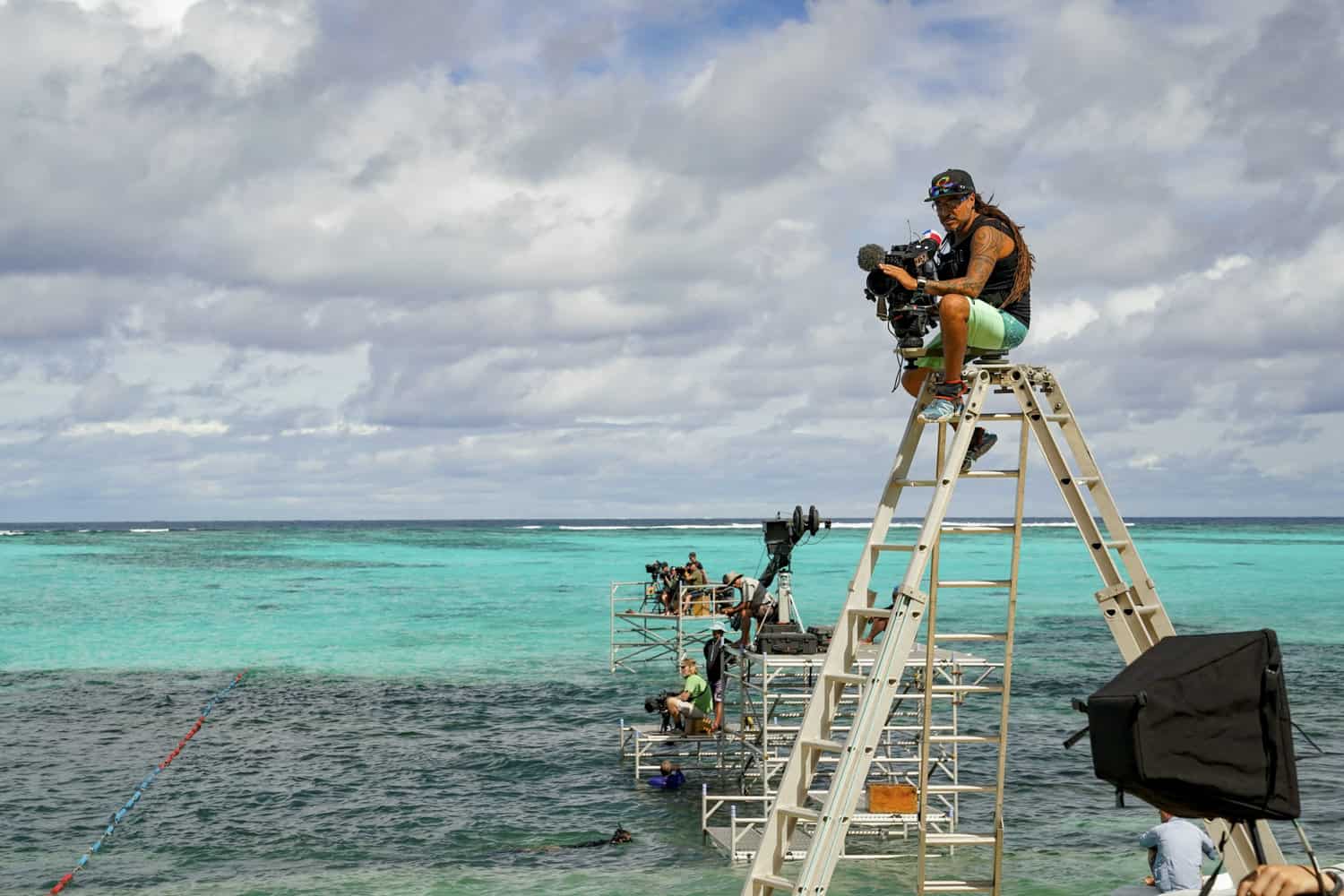
SURVIVOR 40: WINNERS AT WAR, Day 3.
Jim Harrington continues with his assessment of the development of Survivor since he has been away. “After being away for 15 years, coming back for Season 42, I think it’s gotten much bigger. There’s a lot more movement going on. The art department is probably three times the size. The airstrip here on Mana Island is like a city. That’s art, the carpenters, and unit. Paul Messer, who is Unit manager, I think he’s been on the show since the beginning.”
Unit is the bones of the production, the logistics. Unit basically figures out where to put the camera department, where to put marine, where and how to have the camera support on the beaches where the contestants are that is far enough away from them, but we still have places to have our lunch. Unit is slightly similar to locations in the States, but it has a larger umbrella of responsibilities. When there wasn’t a resort for crew, like there is now here in Mana, they took over a piece of land when Survivor was shooting in Africa, the Unit manager determined where the 300 tents housing all the crew will be, where catering is going to be, where production was going to be, and where the bar is going to be. So I think it was a little more extensive then, but in terms of Unit, everything is always there for you that you need. When you show up everything works like a well-oiled machine.
POV CAMERAS
Nixon George started on Survivor in 2007, missing only two years since. He is from the Commonwealth of Dominica. Nixon is now a Reality camera operator, but he has come up the career ladder on Survivor, “In the beginning I started off as an as an AC in Reality, stayed there for a number of years, then I moved on to do the POV cameras for about three years, or six seasons. POV, or point of view cameras, are action cameras, the camera that’s right up close and personal with the contestants, and we get them doing awesome Challenges. These cameras really immerse you into the feel and vibe of the show. So they play a pretty important role.”
“The technology changes in the POV cameras every year. It’s ridiculous. This year, I made a couple of recommendations to switch up the equipment that we had from the year before. It changes drastically every year: the size of the camera, the size of the sensors in the cameras, and now 360 cameras. You just have to make sure that you’re on the ball to try and make sure that we have the best tools to get the best job done.”
“POV cameras are used in both Challenges and Reality. They are used in Reality, but very sparingly. It’s only if the contestants go out fishing that they get used in Reality, but they’re heavily used on the Challenge side, just because of the way things are structured. For Challenges, POV cameras can be placed beforehand as opposed to reality where it’s kind of on the fly and you’re not really sure where it can be used. So today, they welcome me back to my old stomping grounds, a Reality camera operator shooting at the Challenge. I’m looking at my old assistant here setting up all the POV cameras. You can see the joy and pride on my face, seeing that young guy over there, Cullum Andrews. I taught him well. He’s another second-generation employee on Survivor, His dad, Jon Andrews, has been working on Survivor audio for many years, and his brother, George Andrews, has worked on Survivor for a few years as well as a Challenge camera operator. Actually, a side story—when I just started as an AC, his father was one of the first guys that came up to me and just gave me a little vote of confidence and actually gave me some camera equipment so I could start my company back in Dominica. Twelve years later, I had the privilege of paying John back by taking on his son as my assistant, who has now graduated to be the lead POV camera on Survivor.”
“I’ve been doing this since I was like 20 years old, I started my own business back in Dominica just doing video production and photography. So this is all natural. I want to be able to work in the States; I’m also trying to work in the UK. But I already have a path laid out. It’s just taking a bit of time”
Camera Operator Fall 2021
Above Photo: SURVIVOR 39: ISLAND OF THE IDOLS.
Photos by Robert Voets/CBS Entertainment
TECH ON SET
Camera and support equipment supplier: PRG Gear, previously VER
30+ SONY F-800 XDCam Cameras
Canon 40x, Fujinon 21x and 28x lenses: Arri Alexa (Scott Duncan)
RED Monstro Camera (Russ Fill)
Cablecam with a Sony FX3
4 DJI Drone Cameras
Sony IR cameras (night segment producers)
2 Stanton Triangle Jibs
BEHIND THE SCENES
Select Photo for Slideshow
David Frederick’s credits on film and TV series as a cinematographer include The Society, Get Shorty, Muppets From Space, The Soloist, Northern Exposure, Aquarius, The Bridge, and Sons of Anarchy. Currently, Dave is on location in Budapest, Hungary, working as the alternating director of photography on the new Dick Wolf series for CBS, FBI: International. Frederick shoots with every camera and format of film and digital, “There is always a story to be told with a camera. Perhaps it’s a lavish epic captured with remote heads, cranes, helicopters, Steadicam, U/W, gyro rigs or large format anamorphic cameras, or I can film handheld, with the latest small professional digital camera. The ability to share my passion and joy of filmmaking with the director, actors, and crew on any film set is what gets me out of bed in the morning. When I encounter a story rich in integrity and humanity, I thrive on bringing it to life through the lens.”
